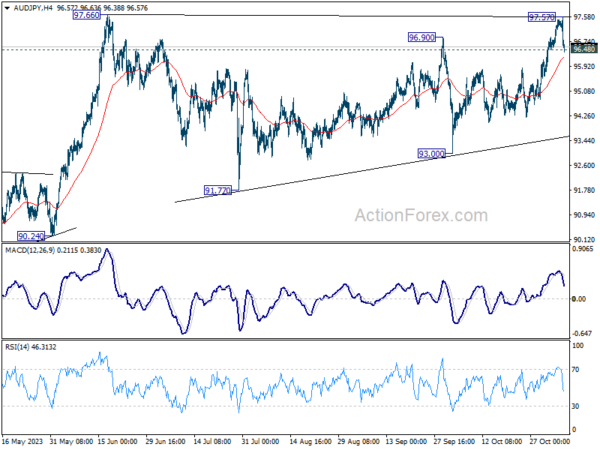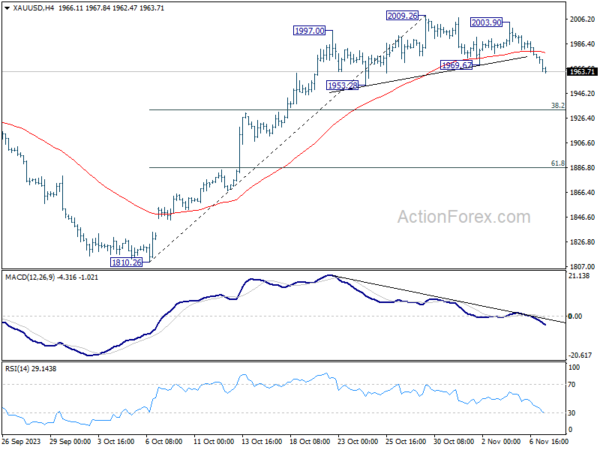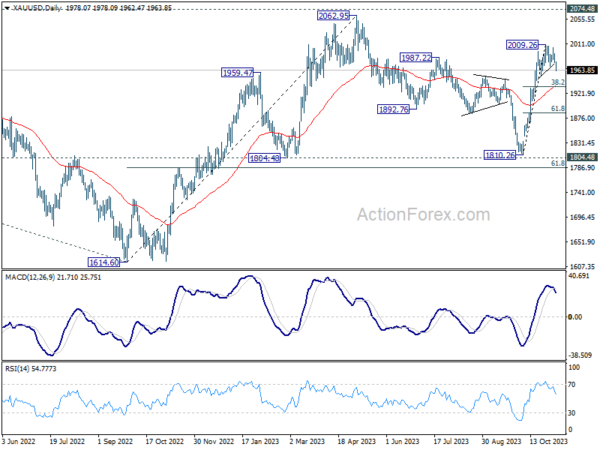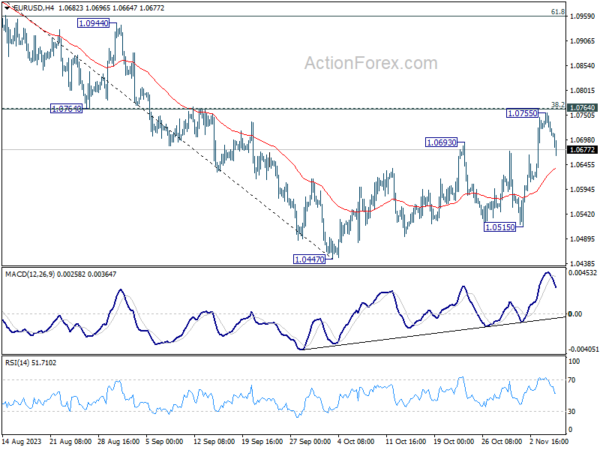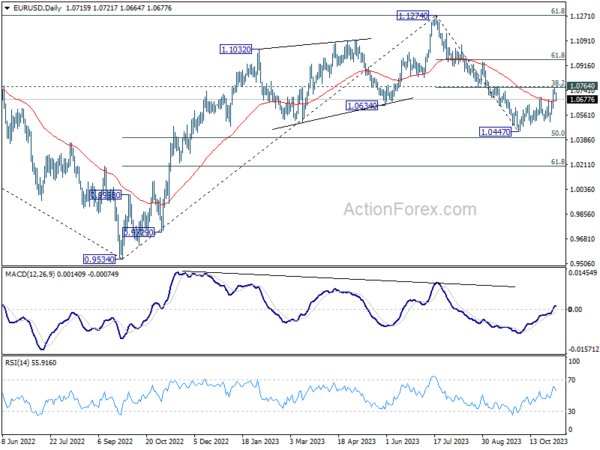As markets across the globe confront a wave of cautious sentiment, Dollar finds itself in a position of strength, capitalizing on a shift in investor mood. European trading sessions have mirrored the apprehensive tone set by Asian markets, although early signs from US pre-markets suggest that the intense selling pressure may be subsiding.
Swiss Franc and Japanese Yen, traditionally seen as safe havens during tumultuous times, rise slightly too . Australian Dollar, however, has been less fortunate, trailing behind with New Zealand Dollar and British Pound. Canadian Dollar is also underperforming, albeit to a lesser extent. Euro stands somewhere in between, struggling to keep pace with its European counterparts.
At the core of the cautious turn in sentiment might be a combination of profit-taking activities, following the previous week’s robust stock rally, and fresh concerns sparked by unsatisfactory economic data. Notably, Germany’s industrial production has taken a sharper downturn than analysts predicted, shrinking by -1.4% mom. Additionally, persistent softness in China’s export figures has contributed to the unease, though a clear driver behind the current mood shift remains elusive.
From a technical perspective, AUD/JPY’s breach of 97.57 minor suggest is taken as an initial sign of rejection by 97.66 resistance. Sustained break of 55 4H EMA (now at 96.22) will argue that the consolidation pattern from 97.66 is extending with another falling leg. In this case, AUD/JPY would head lower towards lower trendline (now at 93.47).
In Europe, at the time of writing, FTSE is up 0.07%. DAX is down -0.14%. CAC is down -0.51%. Germany 10-year yield is down -0.053 at 2.694. Earlier in Asia, Nikkei dropped -1.34%. Hong Kong HSI dropped -1.65%. China Shanghai SSE dropped -0.04%. Singapore Strait Times dropped -0.21%. Japan 10-year JGB yield rose 0.0029 to 0.877.
Gold completes head and shoulder top, how low will it go?
Gold’s decline from 2009.26 continued today and the break of 1969.67 support completed a head and shoulder top pattern (ls: 1997.00, h: 2009.26, rs: 2003.90). The development suggests that it’s already in correction to the whole rally from 1810.26. Further decline should be seen towards 38.2% retracement of 1810.26 to 2009.26 at 1933.24.
Overall outlook is unchanged that correction from 2062.95 has completed with three waves down to 1810.26. Hence, strong support should be seen from 1933.24, which is close to 55 D EMA (now at 1933.62), to contained downside. Another rally through 2009.26 to retest 2062.95 high should be seen sooner rather than later.
However, sustained break of 1933 support zone, will dampen this above bullish view, and open up deeper fall 61.8% retracement at 1886.27, and possibly below.
Eurozone’s PPI at 0.5% mom, -12.4% yoy in Sep
Eurozone PPI came in at 0.5% mom, -12.4% yoy in September, versus expectation of 0.3% mom, -12.5% yoy. For the month, Industrial producer prices increased by 2.2% in the energy sector, while prices remained stable for capital goods and for durable consumer goods, and prices decreased by 0.2% for both intermediate goods and non-durable consumer goods. Prices in total industry excluding energy decreased by 0.1%.
EU PPI came in at -0.6% mom, -11.2% yoy. The biggest monthly increases in industrial producer prices were observed in Luxembourg (+28.5%), Romania (+2.6%) and Bulgaria (+2.1%), while the largest decreases were recorded in Finland (-0.9%), Cyprus and Poland (both -0.3%) and Germany (-0.2%).
RBA hikes to 4.35%, future path hinges on evolving data
RBA announced an increase in cash rate target by 25 bps to 4.35%, aligning with market anticipations. Accompanying this move, RBA signaled a shift to a neutral policy stance, indicating that “whether further tightening of monetary policy is required… will depend upon the data and the evolving assessment of risks .”
In the statement, RBA said inflation is “still too high” and is proving “more persistent than expected a few months ago”. A rate hike was was warranted today to be “more assured” that inflation would return to target in a “reasonable timeframe”.
The central bank’s outlook is tempered by “significant uncertainties,” particularly regarding the persistence of services inflation which has been notably resilient internationally and could mirror in the Australian market.
The effectiveness of monetary policy changes and the response of wage settings and pricing decisions amid a slowdown in economic growth are areas of unpredictability, especially given the current tightness of the labor market. Household consumption prospects are also veiled with uncertainty, too. T
Looking abroad, RBA’s statement brought to light the ongoing global uncertainties, notably the economic trajectory of China and the far-reaching consequences of international conflicts, adding further dimensions to the central bank’s considerations.
China’s export decline deepens while imports rebound
China’s export figures have taken a sharper downturn than anticipated in October, contracting by -6.4% yoy to USD 274.8B, exceeding market predictions of -3.1% yoy. This downturn marks the sixth consecutive month where China’s exports have receded.
In contrast, imports defied expectations with a 3.0% yoy increase, a significant departure from the forecasted -5.4% yoy decline, and putting an end to an 11-month streak of contraction.
The culmination of these trade activities resulted in a considerable narrowing of the trade surplus, which shrunk from USD 77.7B to USD 56.5B. This is a stark contraction compared to the anticipated figure of USD 84.2B.
Japan’s labor cash earnings up 1.2% yoy, but real wages down for 18th month
Japan reported a modest increase in nominal labor cash earnings in September, with 1.2% yoy rise that slightly exceeded market expectations of 1.0% yoy gain. This uptick, an improvement from the previous month’s 0.8%, may seem like a positive indicator at first glance, with base salary growth also marking an increase to 1.4% yoy from August’s 1.2% yoy.
However, not all components of earnings showed strength. Special payments, often a volatile category, continued to decline by -6.0% yoy , albeit a less severe contraction than -6.3% yoy reported in August. Meanwhile, overtime pay exhibited a marginal increase, rising 0.7% yoy, suggesting a modest uptick in extra working hours.
The nuanced picture of Japan’s wage situation becomes more concerning when adjusted for inflation. Real wages, which reflect the purchasing power of income, fell sharply by -2.4% yoy compared to the same month last year, marking the 18th consecutive month of decline. This persistent slide in real wages points to the squeeze on household income as inflation outpaces nominal wage growth.
In line with the strain on incomes, household spending dipped by -2.8% yoy , although the figure is marginally better than the anticipated -3.0% yoy fall. This marks the seventh straight month of decline, underscoring the ongoing reticence of Japanese consumers to open their wallets amid economic uncertainties.
On a more positive note, on a seasonally adjusted basis, household spending saw an unexpected increase of 0.3% mom, defying expectations of a -0.4% mom decline.
EUR/USD Mid-Day Outlook
Daily Pivots: (S1) 1.0703; (P) 1.0730; (R1) 1.0743; More…
Intraday bias in EUR/USD stays neutral at this point. Further rally is in favor as long as 55 4H EMA (now at 1.0638) holds. Decisive break of 1.0764 cluster resistance (38.2% retracement of 1.1274 to 1.0447 at 1.0763) will extend the rise from 1.0447 to 61.8% retracement at 1.0958 next. However, sustained break of 55 4H EMA will argue that the rebound has completed, and target 1.0515 support, and then 1.0447 low.
In the bigger picture, price actions from 1.1274 are viewed as a corrective pattern to rise from 0.9534 (2022 low). Rise from 1.0447 is tentatively seen as the second leg. Hence while further rally could be seen, upside should be limited by 1.1274 to bring the third leg of the pattern.
Economic Indicators Update
| GMT | Ccy | Events | Actual | Forecast | Previous | Revised |
|---|---|---|---|---|---|---|
| 23:30 | JPY | Labor Cash Earnings Y/Y Sep | 1.20% | 1.00% | 1.10% | 0.80% |
| 23:30 | JPY | Overall Household Spending Y/Y Sep | -2.80% | -3.00% | -2.50% | |
| 00:01 | GBP | BRC Like-For-Like Retail Sales Y/Y Oct | 2.60% | 2.80% | ||
| 03:00 | CNY | Trade Balance (USD) Oct | 56.5B | 84.2B | 77.7B | |
| 03:30 | AUD | RBA Interest Rate Decision | 4.35% | 4.35% | 4.10% | |
| 06:45 | CHF | Unemployment rate Oct | 2.10% | 2.10% | 2.10% | |
| 07:00 | EUR | Germany Industrial Production M/M Sep | -1.40% | -0.30% | -0.20% | |
| 08:00 | CHF | Foreign Currency Reserves (CHF) Oct | 658B | 678B | ||
| 10:00 | EUR | Eurozone PPI M/M Sep | 0.50% | 0.30% | 0.60% | 0.70% |
| 10:00 | EUR | Eurozone PPI Y/Y Sep | -12.40% | -12.50% | -11.50% | |
| 12:30 | CAD | Trade Balance (CAD) Sep | 2.0B | 1.0B | 0.7B | |
| 13:30 | USD | Trade Balance (USD) Sep | -61.5B | -60.5B | -58.3B | -58.7B |

